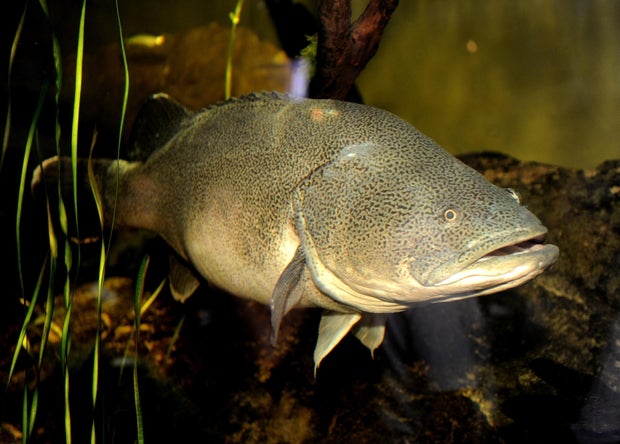A freshwater fish named Arnie just swam a record 530 miles, mostly upstream, Australian scientists say – CBS News

Report on Murray Cod Migration and its Implications for Sustainable Development Goals
Executive Summary
A freshwater Murray cod (Maccullochella peelii) has set a new species record by migrating 530 miles (approximately 853 km) within Australia’s Murray River system. This significant event offers critical data for understanding fish behavior, river connectivity, and the overall health of freshwater ecosystems. The findings directly inform and support efforts related to several United Nations Sustainable Development Goals (SDGs), particularly those concerning biodiversity, water management, and climate action.
Migration Event Details
The subject, a four-year-old specimen nicknamed “Arnie,” was first tagged in early 2022 in Mullaroo Creek. The extensive migration was notably facilitated by flood conditions which necessitated the removal of man-made river barriers, creating free passage for aquatic life. The journey occurred in two distinct phases:
- An initial upstream movement of 470 miles (756 km) accomplished in fewer than two months during the 2022 floods.
- A subsequent downstream return journey of 60 miles (97 km) over the following twelve months.
This movement far surpasses the previously observed maximum migration distance for the species, which was approximately 100 miles (160 km).
Implications for SDG 14 (Life Below Water) and SDG 15 (Life on Land)
The record migration underscores the critical importance of maintaining connected river habitats for the survival and health of aquatic species. This directly supports SDG 14, which aims to conserve and sustainably use aquatic resources. As an apex predator, the Murray cod is a key indicator species; its ability to complete such a journey suggests improved ecosystem health, aligning with the objectives of SDG 15 (Life on Land) to halt biodiversity loss (Target 15.5). The species is currently listed as “vulnerable” under Australia’s environmental legislation due to several persistent threats:
- Historical and ongoing overfishing
- River degradation and habitat loss
- Human modification of the environment
Conservation efforts informed by this research are vital for protecting freshwater biodiversity and achieving these global goals.
Relevance to SDG 6 (Clean Water) and SDG 13 (Climate Action)
This event highlights the success of adaptive river management strategies, such as the temporary removal of barriers. This practice supports SDG 6 (Clean Water and Sanitation), particularly Target 6.5, which calls for integrated water resources management at all levels. Furthermore, the research institute is part of Victoria’s department of energy, environment and climate action, explicitly linking conservation science to SDG 13 (Climate Action). Understanding how species respond to climate-influenced events like floods is essential for developing resilient ecosystems and effective climate adaptation strategies.
The Role of SDG 17 (Partnerships for the Goals)
The discovery was the result of a decade-long fish tagging project involving extensive collaboration and data sharing. This demonstrates the effectiveness of partnerships, a core principle of SDG 17 (Partnerships for the Goals), in achieving complex environmental outcomes. Key collaborating entities in this initiative include:
- The Arthur Rylah Institute
- The Mallee Catchment Management Authority
- The Living Murray program
- The Murray-Darling Basin Authority
Such multi-agency partnerships are fundamental to implementing the large-scale monitoring and management required to meet sustainability targets.
Analysis of Sustainable Development Goals in the Article
1. Which SDGs are addressed or connected to the issues highlighted in the article?
-
SDG 14: Life Below Water
- This goal is relevant as the article’s central subject is the Murray cod, a freshwater fish species. It discusses threats to this species, including overfishing and degradation of its aquatic habitat, which directly relates to the goal of conserving and sustainably using aquatic life.
-
SDG 15: Life on Land
- This goal is also directly addressed because it includes the protection and restoration of inland freshwater ecosystems. The article focuses on the Murray River system, a major freshwater ecosystem. It highlights the “vulnerable” status of the Murray cod, the dramatic decline in its population, and the impact of “river degradation,” all of which are key concerns of SDG 15 regarding biodiversity and ecosystem health.
2. What specific targets under those SDGs can be identified based on the article’s content?
-
Target 14.4: End overfishing, illegal, unreported and unregulated fishing and destructive fishing practices
- The article explicitly states that “More recently, overfishing, river degradation and human modification of the environment have caused major population declines.” This directly connects the issue of the Murray cod’s population decline to the problem of overfishing.
-
Target 15.1: By 2020, ensure the conservation, restoration and sustainable use of terrestrial and inland freshwater ecosystems and their services
- The article discusses the Murray River system, an inland freshwater ecosystem. The research mentioned, which involves tagging fish and understanding their movement, is aimed at adapting water flows to protect their environment. The removal of barriers to allow flood waters and fish to pass is a concrete example of an action toward restoring the natural state of this ecosystem.
-
Target 15.5: Take urgent and significant action to reduce the degradation of natural habitats, halt the loss of biodiversity and, by 2020, protect and prevent the extinction of threatened species
- This target is highly relevant as the article identifies the Murray cod as a “vulnerable” species under Australia’s Environmental Protection and Biodiversity Conservation Act. It notes that the species’ “populations have declined dramatically” and they are “now relatively uncommon,” highlighting the urgent need to protect this threatened species and halt biodiversity loss within its habitat.
3. Are there any indicators mentioned or implied in the article that can be used to measure progress towards the identified targets?
-
Conservation Status of Species
- The article explicitly mentions that the Murray cod is listed as “vulnerable.” This official classification serves as a direct indicator related to Target 15.5. Progress can be measured by monitoring changes in this conservation status over time (e.g., an improvement to a less threatened category or a worsening to ‘endangered’).
-
Population Health and Ecosystem Vitality
- The researcher Zeb Tonkin states, “If we see this species breeding, growing well, migrating well, it’s a pretty good indication that the ecosystem in general is pretty healthy.” This implies that the following can be used as indicators for the health of the freshwater ecosystem (Target 15.1):
- Migration patterns and distances (e.g., the record 530-mile swim).
- Breeding success rates of the species.
- Growth rates of the fish population.
- The researcher Zeb Tonkin states, “If we see this species breeding, growing well, migrating well, it’s a pretty good indication that the ecosystem in general is pretty healthy.” This implies that the following can be used as indicators for the health of the freshwater ecosystem (Target 15.1):
-
Fish Population Levels
- The article notes that “populations have declined dramatically.” Therefore, monitoring the population size and density of the Murray cod over time would be a key indicator to measure the effectiveness of conservation efforts and the impact of managing threats like overfishing (Target 14.4).
4. Summary Table of SDGs, Targets, and Indicators
| SDGs | Targets | Indicators |
|---|---|---|
| SDG 14: Life Below Water | 14.4: End overfishing and destructive fishing practices. | Population levels of Murray cod (implied by the statement that “populations have declined dramatically”). |
| SDG 15: Life on Land | 15.1: Conserve and restore inland freshwater ecosystems. | Health and vitality of the Murray cod population (breeding, growth, and migration patterns) as a proxy for ecosystem health. |
| SDG 15: Life on Land | 15.5: Protect threatened species and halt biodiversity loss. | The official conservation status of the Murray cod (explicitly mentioned as “vulnerable”). |
Source: cbsnews.com
What is Your Reaction?
 Like
0
Like
0
 Dislike
0
Dislike
0
 Love
0
Love
0
 Funny
0
Funny
0
 Angry
0
Angry
0
 Sad
0
Sad
0
 Wow
0
Wow
0
















































:focal(1500,1000)/https://media.globalcitizen.org/a6/9a/a69a4720-d8a1-4715-b596-18738d03c05c/rotary_polio_hero_image.jpg?#)







/countries/sri-lanka/photo-credit---dmc-sri-lanka.tmb-1200v.jpg?sfvrsn=dc298bcc_1#)
















